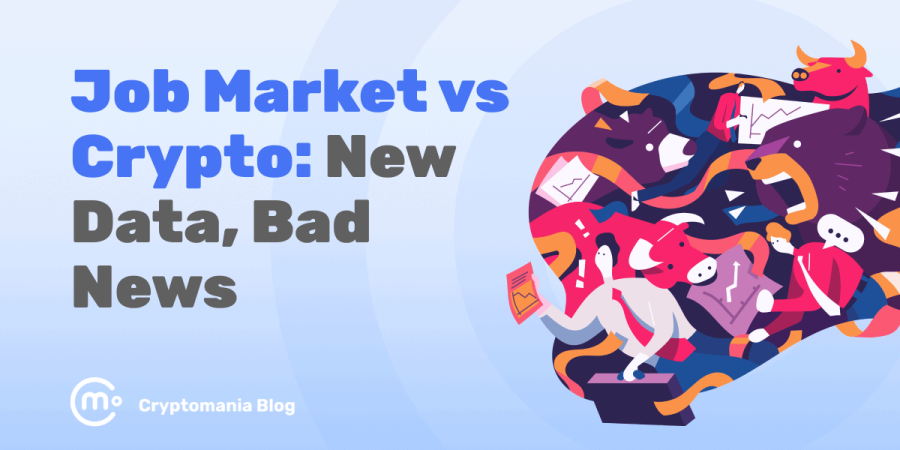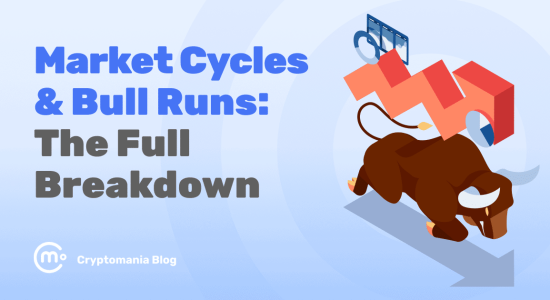
The U.S. just made a big correction to its jobs data. According to new numbers, the economy added 258,000 fewer jobs in May and June 2025 than first reported.
That’s not a small mistake. It’s the biggest two-month revision since 1968, outside of a recession.
The labor market suddenly looks a lot weaker than we thought. And that’s got everyone, from Wall Street to Washington, rethinking what happens next.
Most importantly, it puts pressure on the Federal Reserve to change direction. The Fed has been holding interest rates steady, waiting for more signs of a slowdown. This might be it.
So what does that mean for crypto?
When the Fed changes course, it can ripple through every part of the financial system. And crypto often feels it first, and the hardest.
In this article, we’ll break down what this surprise jobs data means for Bitcoin, Ethereum, and altcoins, and whether it could trigger a new macro setup for crypto.
The big miss: The job market wasn’t as strong as we thought
A historic revision that changed the story
The U.S. Labor Department just dropped a major revision to its job numbers. In early reports, May and June 2025 looked solid, with around 290,000 new jobs combined. But the latest update shows that the number was off by 258,000 jobs.
- In May, the U.S. only added 19,000 jobs (the initial report said it was 144,000)
- In June, the U.S. only added 14,000 jobs (the initial report said it was 147,000)
The new total? Just 33,000 jobs added across those two months.
That’s a massive correction. According to Goldman Sachs, this is the largest May–June revision outside of a recession since 1968. The last time the labor market took a hit this big, the U.S. economy was already in crisis mode.
This changes the entire narrative around the U.S. economy. It tells us that the job market (which had been described as “resilient” by Fed officials) is worse than expected.
Why economists were caught off guard
The scale of this revision was surprising, but also embarrassing.
Wall Street analysts, central bankers, and financial journalists have been leaning on those early numbers to make forecasts. Now they’re being forced to rewrite the script.
Several economists noted how rare this kind of revision is. Usually, initial job numbers are off by a bit, a 20K or 30K change here or there. But cutting more than a quarter-million jobs from the books is not normal.
It’s hard to trust the next set of numbers when the last ones were so far off.
It also undermines the Fed’s recent confidence. Just days before the revision, Fed Chair Jerome Powell called the labor market “solid.” Turns out, it wasn’t. And now, the pressure is building for the Fed to act.
Fed to the rescue? Market bets say a rate cut is coming
In case you’re not aware, interest rates are financial tools that the Fed uses in the following manner:
- The Fed increases interest rates as a method to fight inflation (high interest rates are usually bad for crypto)
- The Fed lowers interest rates as a method to fight a recession and a bad job market (low interest rates are usually good for crypto)
After the pandemic, in 2022 and 2023, the issue was inflation. So, at the time, Fed was increasing interest rates, and we had a crypto bear market. However, more recently, inflation has been cooling off.
At the last meeting on July 30, 2025, the Fed decided to keep interest rates the same, even though some have been calling for them to start lowering the rates (including the U.S. president Donald Trump). The Fed’s rationale was that the job market looks good, so there’s no need to cut the rates.
That’s why the job market news that came just a day later is huge.
A major shift in expectations
Before the jobs report came out, most analysts believed the Federal Reserve would hold interest rates steady until the end of the year. Inflation was cooling, but the labor market still looked strong. There was no urgent reason to cut.
That changed in a single day.
Right after the weak jobs data hit, traders started betting on a quick pivot. According to CME FedWatch, the probability of a September rate cut surged to over 90%, up from around 40% just a week earlier.
It was one of the fastest sentiment shifts we’ve seen all year. Investors went from cautiously neutral to fully pricing in a rate cut, all because the job market now looks shakier than expected.
As CoinCentral put it:
“The Federal Reserve’s next move might not be about inflation anymore. It might be about saving the economy from a slowdown.”
What Powell said – and what markets heard
Jerome Powell has been careful with his words. After the Fed’s July meeting, he said inflation was “moving in the right direction,” but that rate cuts weren’t on the table just yet.
He emphasized that the Fed would stay patient and data-dependent. But the data just changed.
Powell hasn’t commented directly on the revised job numbers yet, but other Fed officials are starting to blink. One regional Fed president said on Monday that the labor market “may have reached a turning point.” Another suggested that if weakness continues, a cut “should be seriously considered.”
Translation? The Fed may no longer have the luxury of waiting.
If job growth continues to stall, or if the unemployment rate ticks higher, the central bank will likely be forced to act. And when it does, that shift could have a huge impact on crypto.
Crypto market reaction: A wild weekend for Bitcoin and altcoins
First came the fear, then came the bounce
Crypto markets didn’t take the news well at first. On Friday, when the jobs data revision dropped, Bitcoin fell by nearly 4%, sliding from around $117K to near $112K. Ethereum and most altcoins saw even bigger losses.
Some smaller-cap tokens dropped 10–15% in a matter of hours. Traders moved fast to reduce exposure, fearing that the labor data might be pointing toward a recession. As always, altcoins got hit harder than BTC during the panic selloff.
Crypto wasn’t the only one feeling it. Stocks dropped, bond yields fell, and volatility spiked. It was a clear risk-off moment, Bitcoin traded right in line with the broader fear.
But by Monday, the mood changed.
The rate-cut rally kicks in
Once the initial panic faded, investors started looking at the upside: weaker jobs data could force the Fed to cut rates earlier than expected.
That triggered a relief rally across multiple markets. The Nasdaq jumped nearly 2%, and small-cap stocks led the charge. Crypto followed.
Bitcoin recovered some of its Friday losses. Several altcoins also bounced, though most didn’t regain their full ground.
It wasn’t a massive pump, more of a cautious reversal.
The market is tense.
- On the one hand, lower interest rates are good for crypto. They mean cheaper capital, looser conditions, and more appetite for risk.
- But on the other hand, rate cuts in response to economic weakness carry a different tone. If a full-blown recession is on the horizon, that’s not exactly bullish.
Right now, investors are betting on a soft landing. It’s where the Fed cuts just enough to keep the economy growing. If that happens, crypto could thrive in the coming 12 months. But if job losses accelerate and consumer spending drops, the bounce may be short-lived.
Bitcoin vs. altcoins: Different reactions, different risks
The past few days also reminded us of a key pattern: Bitcoin reacts first, and altcoins exaggerate the move.
During Friday’s selloff, Bitcoin lost around 4%. Many altcoins lost double that. But when the bounce came on Monday, some altcoins actually outperformed BTC on the way back up.
That’s typical behavior.
- In macro-driven markets, Bitcoin acts like a bellwether. It moves first, with a mix of institutional and retail sentiment behind it.
- Altcoins, especially smaller caps, act more like leveraged bets. When things are good, they run. When things go bad, they tank.
This dynamic matters going forward. If the Fed really does start cutting, and liquidity returns to the market, altcoins may be the biggest winners. But they’re also the biggest risk.
Why crypto cares: Connecting interest rates to Bitcoin pumps
Liquidity is everything in crypto
To understand why crypto reacts so strongly to interest rate news, you have to understand one thing: crypto runs on liquidity.
When money is cheap and flowing through the system (like during the pandemic years), risk assets soar. Investors have more cash to deploy, borrowing is easier, and even retail traders feel more confident chasing gains. That’s exactly what happened in 2020 and 2021. Bitcoin exploded, altcoins went wild, and new projects raised millions overnight.
That all happened because the pandemic caused fears of a recession, so the Fed cut down interest rates and added more dollars into the economy.
But when rates go up? That changes everything.
- Higher interest rates pull liquidity out of the system
- Safe assets like bonds become more attractive
- Borrowing becomes more expensive
- Risky assets, like crypto, often feel the pain the hardest
That’s why Bitcoin has struggled during this tightening cycle. As the Fed raised rates to fight inflation, crypto lost its fuel. Prices fell, trading volumes dropped, and investor appetite shrank. Capital moved into safer places and out of high-risk bets.
Now, with the Fed potentially shifting toward easing, that could flip the script again.
A quick look back: When the Fed helped pump crypto
We’ve seen this movie before.
- In 2019, after a rough 2018 bear market, the Fed started cutting rates again. Bitcoin responded quickly, doubling in price from around $4K to over $8K within months.
- In 2020, when COVID hit, the Fed slashed rates to zero and launched massive stimulus programs. The result was one of the biggest crypto bull markets in history. Bitcoin went from $5K in March to over $60K by the end of 2021. Altcoins and DeFi followed with even more explosive gains.
The pattern is clear: when the Fed loosens monetary policy, crypto rallies. Not always immediately. Not always smoothly. But the direction is typically up.
That’s why traders are watching the Fed so closely right now. If this jobs data really does push the Fed to start cutting again, it could set the stage for a new phase in the crypto cycle.
Investor sentiment: Playing defense while waiting on the Fed
A market split between fear and opportunity
Right now, traders and investors are trying to find a balance.
The weak jobs report clearly rattled the market. It exposed cracks in the economy and triggered short-term fear. But at the same time, it also increased the odds of Fed rate cuts, which historically fuel risk-on rallies, especially in crypto.
So what are investors doing? We’re seeing a mix of caution and early rotation.
- Some traders are moving toward Bitcoin as a relatively safe haven, especially compared to more speculative altcoins.
- Others are pulling money into stablecoins, waiting on the sidelines for clearer macro signals.
A Wintermute trader Jake Ostrovskis said:
“The rally we saw was mostly machine-driven. We’re still seeing strong demand for downside protection.”
That behavior shows the market is cautious, not euphoric. The market is hedging and covering its bases while watching what the Fed does next.
Institutions are watching, but not jumping in just yet
What about institutional players?
So far, the response has been muted. There hasn’t been a sudden wave of new inflows into crypto funds, but there’s a growing sense that a confirmed Fed pivot could change that quickly. Most institutional desks are still macro-driven. They care more about policy and liquidity than meme coins or hype cycles.
If rate cuts do start in September or later this fall, we may see more structured capital return to the space. That could include hedge funds increasing exposure to Bitcoin, or traditional asset managers dipping into ETH and other large caps.
Until then, most are staying ready, holding BTC or cash and waiting for the green light.
What’s next: Cautious optimism, with one eye on the Fed
The job numbers were wrong. And now everything might change.
The U.S. labor market isn’t as strong as we thought. That single data revision, showing 258,000 fewer jobs than originally reported, has already changed expectations across Wall Street. Investors are no longer asking if the Fed will cut rates — they’re asking when.
That shift matters for crypto. Bitcoin, Ethereum, and the broader market thrive when liquidity returns and rates fall. We saw it in 2019. We saw it in 2020. And if the Fed does start easing in response to economic weakness, crypto could enter a new bullish phase.
But we need to be clear: this isn’t a clean setup.
The reason for the potential rate cuts is not just soft inflation; it’s a weakening economy. If the labor market continues to worry or recession fears grow, that could weigh on sentiment across all risk assets, including crypto. A Fed pivot might help, but it’s not the end-all, be-all.
Everyone’s watching Powell and the Fed’s next move. What happens at the next FOMC meeting could set the tone for the rest of 2025:
- If the Fed confirms that cuts are coming? Expect crypto to wake up.
- If they hold off, or inflation returns, expect more sideways or downward action..





